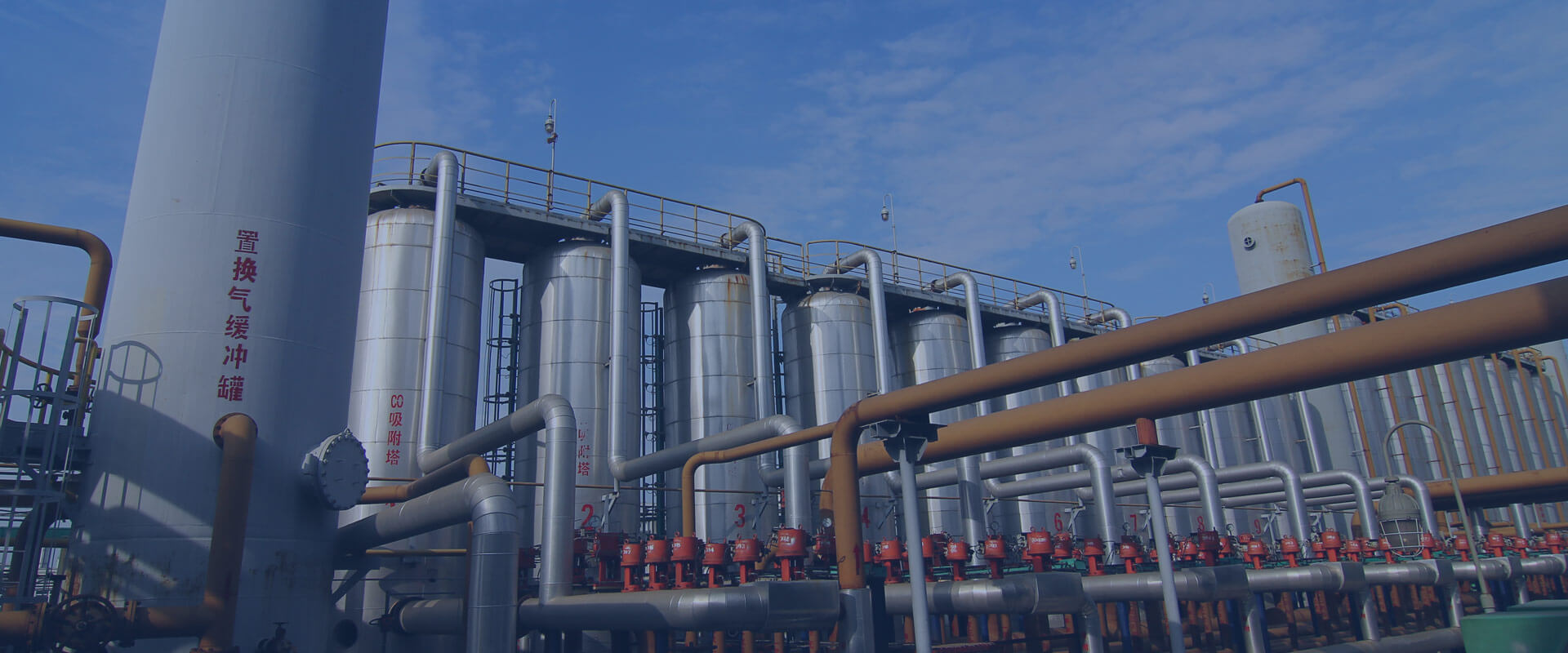
PKU Pioneer’s independently-developed and produced PSA-CO adsorbent PU-1 was granted the Chinese, USA and Canadian patents. PU-1 has ultra-high adsorption capacity and selectivity for CO, which are the key features for PSA-CO technology which reaches the advanced level in the world.
PKU Pioneer originates the high and low consumption PSA-CO technology based on PU-1 adsorbent, achieving the efficient separation of CO from nitrogen, methane and other components, which is of great importance for the carbonyl synthesis industry. This technology won the Second Prize for National Technology Invention.
PKU Pioneer has designed and constructed dozens of PSA-CO plants for the clients, and becomes the highest shares holder in market with the features including low cost of gas product, high purity, high yield, flexibility of feed gas, moderate operating conditions and easy load regulation, which brings much economic earning and market competitiveness to the user.


Wide Applications
PKU Pioneer’s PSA-CO technology is suitable for any CO-rich feed gas.
High Purity and Recovery
The high purity of CO products (95-99.9%) and high recovery (80%-95%) ensure high-quality and low-cost CO gas product for downstream synthesis.
Ranking 1st in Market Share
PKU Pioneer builds most of the PSA-CO plants in China, and holds over 90% of market shares.
Patented Adsorbent
Patented PSA-CO adsorbent PU-1 is highly efficient for producing high-quality CO.

> PKU Pioneer's PSA-CO technology has been successfully applied in ethylene glycol, butyl alcohol, acetic acid, acetic anhydride, formic acid, oxalic acid, oxalacetate, dimethyl formamide, dimethyl carbonate, TDI and MDI.
> PKU Pioneer builds most of the PSA-CO plants in the world, including the world’s largest PSA plant cluster (20,000Nm3/h of O2 product, 20,000Nm3/h of CO product and 40,000Nm3/h of H2 product), the world’s first plant for purifying CO and H2 from calcium carbide exhaust, and the world’s first plant for separating CO from blast furnace gas. Pioneer has absolute leading advantages over the others and become the leading one in CO PSA industry.
Steel Tail Gas Purification
In the process of steel production, a large number of blast furnace gas, converter gas, coke oven gas, rich in carbon monoxide, hydrogen and methane are valuable components, which are the main secondary energy sources of steel works. 55-60% of H2 is contained in coke oven gas, converter gas and blast furnace gas respectively containing 50% ~ 60% and ~25% CO, so steel exhaust completely can be used as a source of chemical synthesis of CO and H2 needed.
>> BFG to CO
Separation of CO from blast furnace gas is an international problem, which is mainly due to the blast furnace gas also contains a large number of N2 and CO2. Because of the close boiling point of N2 and CO, the traditional cryogenic rectification process cannot be used to separate CO from blast furnace gas. The adsorption of CO and N2 is low, and the adsorption of CO2 is easy to poisoning and deactivation, so the conventional pressure swing adsorption method cannot be used for CO separation of blast furnace gas.
PKU Pioneer, on the basis of its mature and leading PSA technology, according to the characteristics of blast furnace gas, developed the process of the formation of a unique CO separation technology of blast furnace gas, by which blast furnace gas can be used from the low cost of mass separation CO. The enriched CO gas can be used for the following three purposes:
1. To produce high value-added chemical products
CO is a kind of important raw material with chemical synthesis which can be purified to 99% from the blast furnace for the production of ethylene glycol, acetic acid, dimethyl carbonate, polycarbonate, TDI, DMF and other chemical products, thus significantly enhancing the added value of the gas. To obtain CO by the use of blast furnace gas has a large cost advantage. With the rapid development in the non-steel industry, it has attracted attention by many domestic and overseas famous iron and steel enterprises.
2. To be premium fuel
The carbon monoxide purified up to 70% from blast furnace, whose heat value is up to 8200kj/nm3, can replace the coal and natural gas for metallurgy, such as the combustion section in iron making links.
3. To be reducing gas of blast furnace injection
The research shows that, to increase concentration of CO from the blast furnace gas and converter gas to above 45%, by the use of separation technology, and then to inject into the blast furnace will significantly improve the carbon monoxide and hydrogen content of the furnace, and indirect reduction acceleration of the sinter in the furnace shell, which helps improve the production and heat efficiency.
Economic Benefit AnalysisPKU Pioneer makes the following calculation according to the present coal-chemistry industry situation. To produce 1m3 CO with high purity by separation and purifying of CO from coal gas cost ¥2.00 at current price of coal, but it only cost less than ¥1.00 to produce 1m3 CO with high purity by separation and purifying of CO from BFG with PKU Pioneer’s technology. This means PKU Pioneer can save 50% of the CO producing cost than coal gas making.
Successful CasesThis technology has been implemented in Hengyang Steel Group. The project design of BFG handling capacity of 67000 Nm3/h, to17500 Nm3 preparation of CO product gas, purity of 70%. CO enriched will be used as an alternate to natural gas and weighs 30% of total gas consumption at full capacity. It created significant economic benefits to the enterprise, and the elimination of the BFG emission, and a significant reduction in carbon emissions.
>>Converter Gas to CO
Separation of CO from converter gas is an international problem, which is mainly due to the converter gas also contains a large number of N2 and CO2. Because of the close boiling point of N2 and CO, the traditional cryogenic rectification process can not be used to separate CO from converter gas. The adsorption of CO and N2 is low, so the conventional pressure swing adsorption method can not be used for CO separation of converter gas.
Based on mature and leading PSA CO technology and the characteristics of converter gas, PKU Pioneer has developed the process of the formation of a unique CO separation technology of converter gas, which can be applied to get over 99% purity of CO product in large capacity from converter gas economically. The enriched CO gas can be used for producing high value-added chemical products.
CO is a kind of important raw material with chemical synthesis. It can purify CO from the converter gas to over 99%, which is used for the production of ethylene glycol, acetic acid, dimethyl carbonate, polycarbonate, TDI, DMF and other chemical products, thus significantly enhancing the added value of the gas. To obtain CO by the use of converter gas has a large cost advantage. With the rapid development in the non-steel industry, it has attracted attention by many domestic and overseas famous iron and steel enterprises.
Economic Benefit Analysis
The remained converter gas can be used for electricity generation except for converter fuel gas use. However, because its calorific value is low, the value added for electricity generation is low, and at the same time the carbon emission is high. The purified CO for chemical synthesis not only can decrease the investment of that from fossil raw material, but also can increase the added value and decrease the carbon emission. It is friendly environmental.
Successful Case
This technology has been applied to Shandong Aside Technology Company, and the flow of the converter gas is 45000 Nm3/h for 18000 Nm3/h CO product, of which the purity is 98.5%. This application is for 200000 t/a methane acid and 50000 t/a oxalic acid. Compared with the converter gas for electricity generation use, 318 thousand tons carbon emission can be saved per year.
Calcium Carbide Furnace Exhaust Purification
There are nearly 400 calcium carbide manufacturing enterprises in China at present whose total annual productivity exceeds 15 million tons. More than 15 billion m3 tail gas of calcium carbide furnace is produced in China every year. It mainly contains CO (75%~90%) which is totally If fully discharged, equaling to the waste of 2.4 million tons of standard coal, and emits 12 million tons of CO2 and more than 900,000 tons of dust every year. It is the best way to save the energy, reduce the emission and transform the waste to treasure by reasonably utilizing CO.
Application of PSA-CO technology in the calcium carbide industry
Purification of CO by the PSA-CO technology may obtain the 99% high-purity CO and synthesize the high value-added chemical products, such as MEG, methyl carbonate, acetic acid, methanol, TDI and DMF.
Economic Benefit
More than 75% of the tail gas of calcium carbide furnace is CO. Purification of CO by the PSA technology and synthesis of the high value-added chemical product such as MEG largely reduce the raw material cost of the high-purity CO. The new-type purification device of PKU Pioneer not only utilizes the high value-added tail gas of calcium carbide furnace, but also gives a new idea for the development of the technology of synthesis gas-to-MEG.
Successful Case
Xinjiang Tianye Group adopts the unique PSA technology of PKU Pioneer to separate the high-purity CO from the tail gas of calcium carbide furnace to synthesize MEG. As the first industrial device synthesizing MEG by the tail gas of calcium carbide furnace in China, it completely solves the problem of tail gas reclamation. Besides, it not only promotes the emission reduction but also largely reduces the raw material cost of high-purity CO which saves a lot of gas generation expenses.
Phosphorus Off-Gas Purification
The content of CO in the yellow phosphorus tail gas reaches up to 90%. Yellow phosphorus tails gas belongs to the ore smelting tail gas whose components are complicated and impurities are various. The existence of phosphorus and sulfur in the tail gas utilization may corrode the equipment and shorten the life of the catalyst, so the utilization rate is quite low.
The yellow phosphorus resource is abundant in China and deposit reaches 800-1000 thousand tons, which weighs 80% in the world. In absence of the efficiency and advanced purification technique and utilization mode, the yellow phosphorus plant only burns little tail gas to dry the raw material or for the boiler combustion but most of the tail gas is discharged, thus greatly wasting the resource, intensifying the environmental pollution and obstructing the energy saving and emission reduction.
Besides, the resource utilization of C1 chemical products requires deep purification of the impurity in the raw gas, but impurities such as phosphorus, sulfur, arsenic, cyanogens and fluorine in the yellow phosphorus tail gas may result in the toxication of the chemical catalyst and corrosion of the material. Purification depth of the impurity determines the utilization value of the yellow phosphorus tail gas.
Application of PKU Pioneer technology in the yellow phosphorus industry Utilization mode of the tail gas depends on the purification degree. There are three existing purification techniques of the yellow phosphorus tail gas: the traditional alkali washing method can only be applied to the extensive purification; the temperature-change PSA method is complicated and consumes much energy; the general catalytic oxidation method may not realize the continuous dephosphorization and consumes much catalyst. Recently, in view of the atmosphere and purification situation of the yellow phosphorus tail gas, PKU Pioneer has developed a brand-new dephosphorization catalyst, the DePOx catalyst, which may realize the continuous dephosphorization with various impurities in the yellow phosphorus tail gas that the dephosphorization process is not renewed and is simple in the technique. The dephosphorized gas may be used in the combustion power generation or synthesis of the C1 chemical production in combination with other purification techniques.

